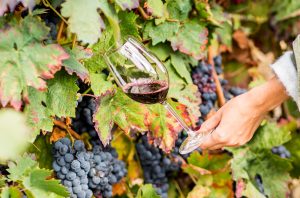We have all become too familiar with news headlines reporting on record-breaking temperatures in recent years. Extended periods of extreme heat, alongside other dramatic weather events, have highlighted the importance of urgently discussing the effects of climate change and of mitigating its consequences. These have a particular effect on the balance of ecosystems and vegetative cycles, namely that of the vines, in turn affecting the successful ripening of grapes.
Record-breaking 2022
The last harvest proved particularly complex. Zoe, the first ever heatwave to be named, raged through Europe during a nightmarish summer, with lasting consequences. The compound effect of high temperatures and severe drought proved particularly destructive for vineyards, with both Spain and Greece reporting a drop in production of up to 44% in certain regions.
‘Over the past few years there have been many extreme weather events,’ explains Rosana Lisa, Head Winemaker at Lalomba. ‘2017 was very hot and dry, followed by the milder 2019 and 2020, but there were periods of incredible heat every single year, especially in spring. 2022, however, was record-breaking on all accounts. In mid-May we already had temperatures of more than 30ºC, which did not drop until late September.’
Battling to survive
Such steadily high temperatures had a direct and severe impact on the vineyards. If a certain level of stress is conducive to the production of more complex and concentrated grapes, an overly stressed plant will simply ‘shut down’ and halt the ripening process.
‘Heat increases evapotranspiration [through the leaves] in the vines which reduces water availability,’ explains Lisa. ‘The plant reacts by closing its stomata to avoid further water loss, slowing down the photosynthesis. At this point the plant’s metabolism stops and ripening will not progress.’ While the accumulation of sugar – and other flavour compounds – in the berries is suspended, there is a decrease in malic acid which the plant uses as an alternative energy source. The ultimate result are grapes with higher alcohol potential – although sugar production stops the berries lose water through evaporation, therefore concentrating whatever sugar which was there at shut down – less acidity and less flavour compounds. The repercussions are even sharper in plots traditionally harvested earlier, where ripening happens faster.

The severity of the consequences is not, however, only a matter of vineyard location and aspect, with each variety having a different behaviour. ‘Early ripening varieties, with shorter maturation cycles, such as Pinot Noir, Tempranillo, Sauvignon Blanc, are those who suffer the most and, depending on site, need irrigation to ensure successful maturation’ continues Lisa. The need is even greater on sandy soils, with fast drainage and poor water retention, and high altitude sites that reach higher daytime temperatures. On the other hand, late-ripening varieties, such as Garnacha and Maturana Tinta, withstand extreme weather events much better, highlighting the value of their adaptiveness and rustic strength.
Future strategies
With extreme weather events seemingly becoming the ‘new normal’, producers have started to research and implement strategies to improve the resilience of their vineyard stock. With water shortages also becoming ever more severe, coping strategies will be a necessity to ensure consistency of production in a challenging environment. ‘Planting on higher altitude sites, with milder average temperatures, and on soils with high clay content [for better water retention] helps maintain a cooler environment for vines to grow,’ says Lisa, when explaining some of the criteria informing future, long term, decisions of vineyard relocation. Different row orientation will be another important factor, as will the research on alternative varieties, with longer maturation cycles and better resistance to drought. Is there anything to be done to existing vineyards? According to Lisa, the goal is to delay the vegetative cycle as much as possible, at once reducing the possible impact of spring frosts and delaying budburst. Detailed and exhaustive canopy management is among the foremost techniques, alongside precision irrigation, where legislation allows.
As nature reacts to the human exhaustion of earth’s resources, it is important to work with, and not against it, to overcome the challenges of the future.









